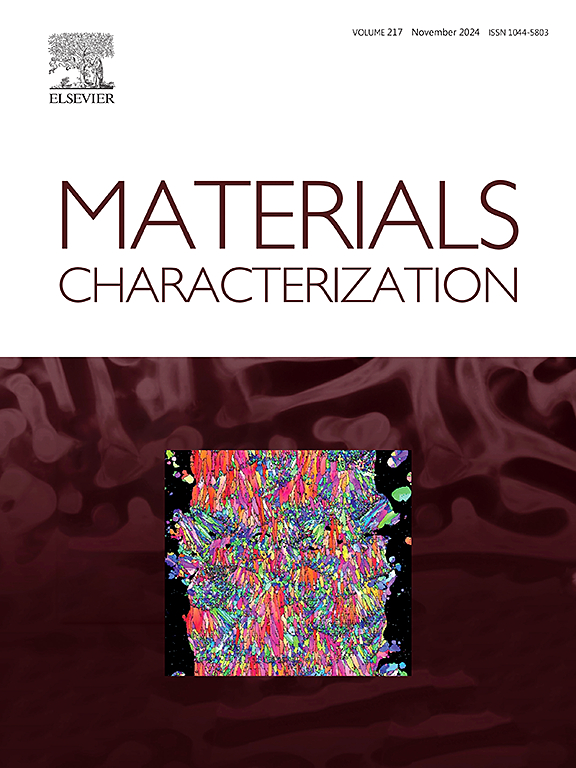Microstructural evolution mechanism and mechanical performance of nanocrystallized surface induced by high-strain-rate plastic deformation
IF 5.5
2区 材料科学
Q1 MATERIALS SCIENCE, CHARACTERIZATION & TESTING
引用次数: 0
Abstract
A surface nanocrystallization (SNC) method using high-strain-rate severe plastic deformation (SPD) via diamond rotary rolling treatment (DRRT) technology was employed to achieve a nanostructured surface in 316 L stainless steel. The DRRT specimens showed a maximum strain rate of 250 s−1. The maximum compressive residual stresses were − 421 MPa in the machining direction (MD) and − 689 MPa in the perpendicular direction (PD). The maximum surface hardness reached 575 HV with a hardening depth of 1100 μm. The DRRT specimen with optimal strength-ductility balance achieved an ultimate tensile strength of 757 MPa while maintaining 38 % uniform elongation. Microstructural characterizations revealed that the high-strain-rate SPD process was accompanied by complex microstructural changes, including dislocations, slips, stacking faults, twinning, grain refinement, and multiphase of face-centered cubic austenite (fcc-γ), body-centered cubic martensite (bcc-α') and hexagonal close-packed martensite (hcp-ε). Different regions of the gradient micro-nano structure exhibited distinct martensitic transformation mechanisms. In the high-strain-rate deformation zone near the surface, the γ → ε → α' phase transformation mechanism was observed, whereas the transformation mechanism of γ → austenite twinning → α' occurred in the lower strain-rate deformation zone deeper from the surface. Notably, the phenomenon of detwinning was observed in the high-strain-rate region, which may be related to the inhibition from the intermediate ε-hcp phase during the phase transformation. Based on these results, the co-evolution mechanism of grain refinement and martensitic phase transformation under high-strain-rate conditions was revealed. The combined effects of high-strain-rate SPD, martensitic phase transformation, grain refinement, and detwinning resulted in the nanocrystallization of coarse-grained austenite.
高应变速率塑性变形诱导纳米晶表面微观组织演化机制及力学性能
采用金刚石旋转轧制(DRRT)技术,采用高应变速率剧烈塑性变形(SPD)的表面纳米化(SNC)方法,制备了316 L不锈钢的纳米结构表面。DRRT试样的最大应变速率为250 s−1。加工方向(MD)和垂直方向(PD)的最大残余压应力分别为- 421 MPa和- 689 MPa。最大表面硬度为575 HV,硬化深度为1100 μm。具有最佳强度-延性平衡的DRRT试样在保持38%均匀伸长率的同时,获得了757 MPa的极限拉伸强度。显微组织表征表明,高应变速率SPD过程伴随着复杂的显微组织变化,包括位错、滑移、层错、孪晶、晶粒细化以及面心立方奥氏体(fcc-γ)、体心立方马氏体(bcc-α′)和六方密排马氏体(hcp-ε)的多相相变。梯度微纳结构的不同区域表现出不同的马氏体转变机制。在近表面的高应变速率变形区,发生γ→ε→α′相变机制,而在离表面较深的低应变速率变形区,发生γ→奥氏体孪晶→α′相变机制。值得注意的是,在高应变速率区域出现了脱孪现象,这可能与相变过程中中间相ε-hcp的抑制作用有关。在此基础上,揭示了高应变速率条件下晶粒细化与马氏体相变的共同演化机制。高应变速率SPD、马氏体相变、晶粒细化和脱孪生的共同作用导致粗晶奥氏体纳米化。
本文章由计算机程序翻译,如有差异,请以英文原文为准。
求助全文
约1分钟内获得全文
求助全文
来源期刊

Materials Characterization
工程技术-材料科学:表征与测试
CiteScore
7.60
自引率
8.50%
发文量
746
审稿时长
36 days
期刊介绍:
Materials Characterization features original articles and state-of-the-art reviews on theoretical and practical aspects of the structure and behaviour of materials.
The Journal focuses on all characterization techniques, including all forms of microscopy (light, electron, acoustic, etc.,) and analysis (especially microanalysis and surface analytical techniques). Developments in both this wide range of techniques and their application to the quantification of the microstructure of materials are essential facets of the Journal.
The Journal provides the Materials Scientist/Engineer with up-to-date information on many types of materials with an underlying theme of explaining the behavior of materials using novel approaches. Materials covered by the journal include:
Metals & Alloys
Ceramics
Nanomaterials
Biomedical materials
Optical materials
Composites
Natural Materials.
 求助内容:
求助内容: 应助结果提醒方式:
应助结果提醒方式:


